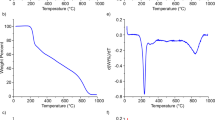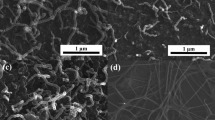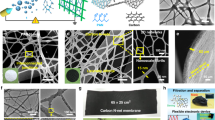Abstract
Both fullerenes and single-walled carbon nanotubes (SWNTs) exhibit many advantageous properties1. Despite the similarities between these two forms of carbon, there have been very few attempts to physically merge them2,3. We have discovered a novel hybrid material that combines fullerenes and SWNTs into a single structure in which the fullerenes are covalently bonded to the outer surface of the SWNTs. These fullerene-functionalized SWNTs, which we have termed NanoBuds, were selectively synthesized in two different one-step continuous methods, during which fullerenes were formed on iron-catalyst particles together with SWNTs during CO disproportionation. The field-emission characteristics of NanoBuds suggest that they may possess advantageous properties compared with single-walled nanotubes or fullerenes alone, or in their non-bonded configurations.
This is a preview of subscription content, access via your institution
Access options
Subscribe to this journal
Receive 12 print issues and online access
$259.00 per year
only $21.58 per issue
Buy this article
- Purchase on Springer Link
- Instant access to full article PDF
Prices may be subject to local taxes which are calculated during checkout




Similar content being viewed by others
References
Dresselhaus, M. S., Dresselhaus, G. & Eklund, P. C. Science of Fullerenes and Carbon Nanotubes (Academic Press, San Diego, 1996).
Smith, B. W., Monthioux, M. & Luzzi, D. E. Encapsulated C60 in carbon nanotubes, Nature 396, 323–324 (1998).
Urita, K. Y. et al. Defect-induced atomic migration in carbon nanopeapod: tracking the single-atom dynamic behaviour. Nano Lett. 4, 2451–2454 (2004).
Moisala, A., Nasibulin, A. G., Shandakov, S. D., Jiang, H. & Kauppinen, E. I. On-line detection of single-walled carbon nanotube formation during aerosol synthesis method. Carbon 43, 2066–2074 (2005).
Nasibulin, A. G., Moisala, A., Brown, D. P., Jiang, H. & Kauppinen, E. I. A novel aerosol method for single walled carbon nanotube synthesis. Chem. Phys. Lett. 402, 227–232 (2005).
Nasibulin, A. G. et al. An essential role of CO2 and H2O during SWNT synthesis from carbon monoxide. Chem. Phys. Lett. 417, 179–184 (2006).
Smith, B. W. & Luzzi, D. E. Formation mechanism of fullerene peapods and coaxial tubes: a path to large scale synthesis. Chem. Phys. Lett. 321, 169–174 (2000).
Bachilo, S. M. et al. Structure-assigned optical spectra of single-walled carbon nanotubes. Science 298, 2361–2366 (2002).
O'Connell, M. J. et al. Band gap fluorescence from individual single-walled carbon nanotubes. Science 297, 593–596 (2002).
Weisman, R. B., Heymann, D. & Bachilo, S. M. Synthesis and characterization of the ‘missing’ oxide of C60: [5,6]-open C60O. J. Am. Chem. Soc. 123, 9720–9721 (2001).
Benedetto, A. F., Bachilo, S. M. Weisman, R. B., Nossal, J. R. & Billups, W. E. Photophysical studies of 1,2-C70H2 . J. Phys. Chem. A 103, 10842–10845 (1999).
Eklund, P. C., Holden, J. M. & Jishi, R. A. Vibrational modes of carbon nanotubes; spectroscopy and theory. Carbon 33, 959–972 (1995).
Lin-Vien, D., Colthup, N. B., Fateley, W. G. & Grasselli, J. G. The Handbook of Infrared and Raman Characteristic Frequencies of Organic Molecules (Academic Press, Boston, San Diego, New York, London, Sydney, Tokyo, Toronto, 1991).
Hornbaker, D. J. et al. Mapping the one-dimensional electronic states of nanotube peapod structures. Science 295, 828–831 (2002).
Frauenheim, T. et al. Atomistic simulations of complex materials: ground state and excited state properties. J. Phys. Condens. Matter 14, 3015–3047 (2002).
Banerjee, S., Hemraj-Benny, T. & Wong, S. S. Covalent surface chemistry of single-walled carbon nanotubes. Adv. Mater. 17, 17–29 (2005).
Berber, S., Kwon, Y.-K. & Tománek, D. Microscopic formation mechanism of nanotube peapods. Phys. Rev. Lett. 88, 185502 (2002).
Kim, S. & Tománek, D. Melting the fullerenes: a molecular dynamics study. Phys. Rev. Lett. 72, 2418–2421 (1994).
Nasibulin, A. G., Pikhitsa, P. V., Jiang, H. & Kauppinen, E. I. Correlation between catalyst particle and single-walled carbon nanotube diameters. Carbon 43, 2251–2257 (2005).
Nasibulin, A. G. et al. Studies on mechanism of single-walled carbon nanotube formation. J. Nanosci. Nanotechnol. 6, 1233–1246 (2006).
Shibuta, Y. & Maruyama, S. Molecular dynamics simulation of generation process of SWNTs. Physica B 323, 187–189 (2002).
Ding, F., Rosén, A. & Bolton, K. The role of the catalytic particle temperature gradient for SWNT growth from small particles. Chem. Phys. Lett. 393, 309–313 (2004).
Talyzin, A.V. et al. Gentle fragmentation of C60 by strong hydrogenation: a route for synthesising new materials. Chem. Phys. Lett. 400, 112–116 (2004).
Graff, R. A. et al. Achieving individual-nanotube dispersion at high loading in single-walled carbon nanotube composites. Adv. Mater. 17, 980–984 (2005).
Yang, C., Zhong, Z. & Lieber, C. M. Encoding electronic properties by synthesis of axial modulation-doped silicon nanowires. Science 310, 1304–1307 (2005).
Acknowledgements
We would like to thank V. Pore, A.-S. Jääskeläinen, M. Leskelä and Sangsun Yang for their assistance with UV–vis and field emission measurements. Financial support from the Academy of Finland and the Creative Research Initiatives Program supported by the Korean Ministry of Science and Technology is acknowledged. Partial financial support for this work has been provided by NSF NSEC grant no. 425826. G.L. thanks JSPS for financial support.
Author information
Authors and Affiliations
Contributions
A.G.N., P.V.P. and E.I.K. conceived and designed the experiments. H.J., P.V.P., A.S.A., D.P.B., P.Q., D.G., A.M. and G.L. performed the experiments. A.G.N., P.V.P., E.I.K., D.B.P., S.D.S., D.E.R. and M.C. analysed and interpreted the data. A.G.N., D.P.B., P.V.P., E.I.K., A.H., A.V.K. and D.T. co-wrote the paper. A.V.K. is responsible for computer atomic simulations. G.L. and A.H. are responsible for STM measurements. All authors discussed the results and commented on the manuscript.
Corresponding authors
Ethics declarations
Competing interests
The authors declare no competing financial interests.
Supplementary information
Supplementary Information
Supplementary figures S1—S11 (PDF 1849 kb)
Rights and permissions
About this article
Cite this article
Nasibulin, A., Pikhitsa, P., Jiang, H. et al. A novel hybrid carbon material. Nature Nanotech 2, 156–161 (2007). https://doi.org/10.1038/nnano.2007.37
Received:
Accepted:
Published:
Issue Date:
DOI: https://doi.org/10.1038/nnano.2007.37
This article is cited by
-
Tailoring and functionalizing the graphitic-like GaN and GaP nanostructures as selective sensors for NO, NO2, and NH3 adsorbing: a DFT study
Journal of Molecular Modeling (2023)
-
Mechanical properties of fullerene embedded silicon nanowires
Archive of Applied Mechanics (2023)
-
Transition metal (X = Mn, Fe, Co, Ni, Cu, Zn)-doped graphene as gas sensor for CO2 and NO2 detection: a molecular modeling framework by DFT perspective
Journal of Molecular Modeling (2023)
-
Tribocorrosion Framework of (Iron, Nickel, Zinc)-Doped Graphene Nanosheet: New Sights into Sulfur Dioxide and Hydrogen Sulfide Removal Using DFT/TD-DFT Methods
Journal of Bio- and Tribo-Corrosion (2023)
-
Carbon nanotube/graphene nanocomposites built via surfactant-mediated colloid assembly as metal-free catalysts for the oxygen reduction reaction
Journal of Materials Science (2021)



